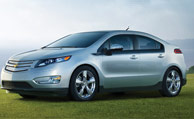
By Kirk Bell of New Car Test Drive
The Chevrolet Volt represents the next step in electric propulsion. It is an extended range electric vehicle that is always powered by electricity.
The powertrain consists of an electric motor, a small FlexFuel-capable four-cylinder engine (probably 1.4-liters), and a 16 kWh lithium-ion battery pack. With a full charge, the Volt can go up to 40 miles on electricity alone. After that, the gas engine will act as a generator to charge the battery, which, in turn, will power the vehicle. Chevrolet says the engine will extend the car’s range to 300 miles.
Owners will be able to charge the Volt using either a 110- or 220-volt outlet. Charging will take eight hours for a 110-volt outlet, four hours for a 220-volt outlet.
Preliminary testing indicates that the Volt will receive an EPA city fuel economy rating of 230 mpg. Of course, that number can be skewed by how people drive. Owner who drive less than 40 miles in the city and charge their cars between trips won’t use any gasoline, though they will have to pay for the electricity needed to charge their cars. Owners who drive 300 miles between charges might see fuel economy in the 30s or 40s. Chevrolet claims that 75 percent of Americans have a daily commute of less than 40 miles.
The Volt is a compact four-door hatchback with four-passenger capacity. The battery pack is placed along the center of the vehicle that has traditionally housed a driveshaft. As such, it uses the space that would otherwise be used for a rear center seat.
The Volt’s instrument panel will include an Efficiency Meter to provide real-time feedback on driving efficiency. The car will also have a Green Leaf screen in the center stack to show Power Flow, Charging and Energy information. The heating and cooling system will have three efficiency modes to maximize climate control capabilities or fuel efficiency.
Chevrolet has announced that, through OnStar, Volt owners will be able to use their smartphones to stay connected to their cars. The application is available for the Droid by Motorola, Apple iPhone or Blackberry Storm, and it can also be used by other phones with mobile browsers or by personal computers. The application will allow users to: display the car’s charge status; set the car to charge now or at a scheduled time (including during off-peak hours); display percentage of battery charge, as well as electric and total ranges; send text or email notifications for charge reminders, interruptions and full charge; display miles per gallon, electric only miles, and odometer readings for last trip and vehicle lifetime; and remotely start the vehicle to activate the climate control system using power from the grid, not the batteries. Other OnStar features will be accessible as well, including door lock/unlock and remote horn and lights.
The 2011 Chevrolet Volt will be offered by the end of 2010 in California and Michigan at a starting price of around $40,000. Chevrolet expects to sell 8000 cars in its first full year, then ramp up production as the car is offered nationwide.







